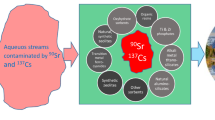Abstract
The paper aims at the analysis of principal factors affecting interaction of radiocobalt with freshwater solids, important for migration of radiocobalt in surface streams. Uptake and release of radiocobalt by sediment from a small river have been studied as a function of pH and composition of aqueous phase, the cobalt concentration and contact time, using laboratory model experiments. A factor of primary importance is the contact time due to slow and two-step kinetics of radiocobalt uptake, which also strongly depends on the concentration of sediment in suspension. pH exerts the most significant effect on the interaction in the pH region of 5–7.5, where the uptake increases with pH. Ionic strength of water phase (I) and concentration of cobalt in water (c) affect the interaction only at rather high values of I or c and their variation can be neglected in the modelling of radiocobalt transport in streams under ordinary conditions. Desorption by river water of radiocobalt pre-adsorbed on the sediment passes through a maximum with desorption time, decreases with increasing adsorption time and increases upon drying of the sediment prior to desorption. Results obtained are compared with literature data and conclusions are drawn concerning the mechanism of radiocobalt uptake by the sediment.
Similar content being viewed by others
References
R. FUKAI, C. N. MURRAY, Environmental behaviour of radiocobalt and radiosilver released from nuclear power stations into aquatic systems. In: Environmental Behaviour of Radionuclides Released in the Nuclear Industry, Vienna, IAEA 1973, p. 217.
P. BENEŠ, Rádioaktivita a životné prostredie 8 (1985) 119 (in Czech).
P. BENEŠ, M. JURÁK, Rádioaktivita a životné prostredie 8 (1985) 205 (in Czech).
P. BENEŠ et al., J. Radioanal. Nucl. Chem., 125 (1988) 295.
A. TESSIER, P. G. C. CAMPBELL, M. BISSON, Anal. Chem., 51 (1979) 844.
A. Y. YOUSEF, The Transport of58Co in an Aqueous Environment. Ph. D. Thesis, University of Texas, 1964.
C. N. MURRAY, L. MURRAY, Adsorption-desorption equilibria of some radionuclides in sediment-fresh-water and sediment-seawater systems.In: Radioactive Contamination of the Marine Environment, Vienna, IAEA 1973, p. 115.
A. VERTACNIK, P. STROHAL, S. LULIC, Health Phys., 36 (1979) 491.
A. S. ABDEL-GAWAD, R. M. K. EL-SHINAWY, W. E. Y. ABDEL-MALIK, Intern. J. Appl. Radiation Isotopes, 32 (1981) 623.
J. F. HODGSON, K. G. TILLER, M. FELLOWS, Soil. Sci. Soc. Am. Proc., 28 (1964) 42.
P. H. TEWARI, A. B. CAMPBELL, W. LEE, Can. J. Chem., 50 (1972) 1642.
J. ŠIPALO-ŽULJEVIĆ, R. H. H. WOLF, Mikrochim. Acta, (1973) 315.
J. W. MURRAY, Geochim. Cosmochim. Acta, 39 (1975) 635.
D. R. KESTER, T. P. O'CONNOR, R. H. BYRNE, Jr., Thalassija Jugoslavica, 11 (1975) 121.
R. T. LOWSON, J. V. EVANS, Aust. J. Chem., 37 (1984) 2165.
P. BENEŠ, V. MAJER, Trace Chemistry of Aqueous Solutions, Academia-Elsevier, Prague-Amsterdam, 1980, p. 175 and 199.
R. M. SMITH, A. E. MARTELL, Critical Stability Constants, Vol. 4,Plenum Press, New York, 1976.
R. FUKAI, L. NUYNH-NGOC, Studies on the chemical behaviour of radionuclides in seawater, I. In: Radioactivity in the Sea. Publ. No. 22, Vienna, IAEA 1968, p. 1.
R. O. JAMES, T. W. HEALY, J. Coll. Interf. Sci., 40 (1972) 42.
W. STUMM, J. J. MORGAN, Aquatic Chemistry. Wiley-Interscience, New York 1970, p. 463.
E. K. DUURSMA, D. EISMA, Neth. J. Sea Res., 6 (1973) 265.
J. F. HODGSON, Soil. Sci. Soc. Amer. Proc., 24 (1960) 165.
P. BENEŠ M. JURÁK, Interaction of radiocobalt with sediments in surface waters. In: Radionuclides and Ionizing Radiation in Water Technology, Proc. Conf., CSVTS, Harrachov 1985, p. 94 (in Czech).
P. PICAT et al., Study of the physicochemical form of cobalt in the Loire River. In: Speciation of Fission and Activation Products in the Environment, Proceedings of the seminar CEC, Oxford 1985, p. 269.
A. S. ABDEL-GAWAD et al., Intern. J. Appl. Radiation Isotopes, 28 (1977) 705.
S. R. ASTON, E. K. DUURSMA, Neth. J. Sea Res., 6 (1973) 225.
R. CHESTER, Nature, 106 (1965) 884.
T. P. O'CONNOR, The Adsorption of Copper and Cobalt from Aqueous Solutions onto Illite and Other Substrates. Ph. D. Thesis, Univ. of Rhode Island, 1974.
K. A. MAHMOUD et al., Transfer mechanism and concentrating processes of certain radionuclides in the aquatic ecology of the Ismailia Canal. In: Environmental Behaviour of Radionuclides Released in the Nuclear Industry, IAEA, Vienna 1973, p. 205.
T. KAWABATA, J. Rad. Res., 8 (1967) No. 1, 20.
E. K. DUURSMA, J. C. BOSCH, Neth. J. Sea Res., 4 (1970) 395.
Author information
Authors and Affiliations
Rights and permissions
About this article
Cite this article
Beneš, P., Jurák, M. & Kuncová, M. Factors affecting interaction of radiocobalt with river sediments. Journal of Radioanalytical and Nuclear Chemistry, Articles 132, 209–223 (1989). https://doi.org/10.1007/BF02136081
Received:
Issue Date:
DOI: https://doi.org/10.1007/BF02136081




